Why RChilli Taxonomy is Crucial for Recruiters in Oracle HCM?
by Aanchal Sharma
Ever since the competition to hire skilled candidates is becoming fierce, the companies needs to shift their attention on tracking candidate competencies and benefiting from them. The best way to ensure this is through robust skills taxonomy. Here’s how RChilli’s skills taxonomy help Oracle recruiters.
In an era where new jobs and profiles are constantly created, the skills are also evolving. The shelf life of a particular technical skill is said to be less than six years. It doesn’t take much time for a stagnant taxonomy to become obsolete fast.
Can you calculate the number of talented candidates lost because their resumes didn’t include the skills mentioned in the job description? While the number can be alarming, the problem is common in recruitment.
Research conducted by Manpower Group shows a startling percentage of skills gaps across industries:
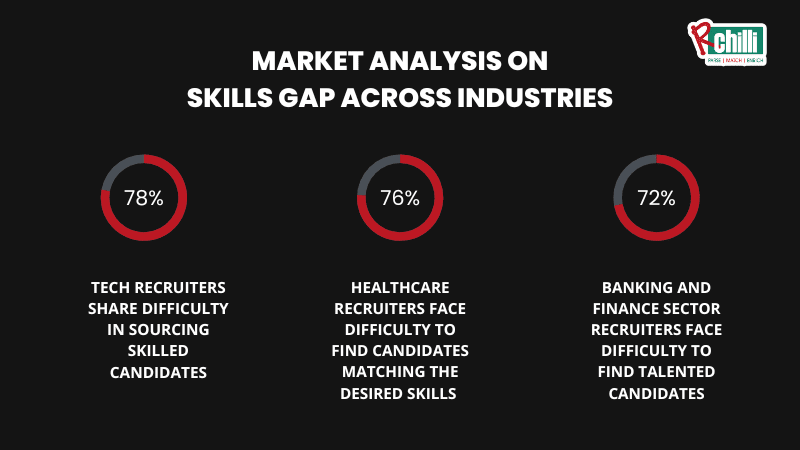
Industries including construction, retail, education, and hospitality have too made it to the list of facing difficulty in sourcing employees with required skills.
At the same time, the job market shows 1.8 open positions for each unemployed professional.
Additionally, by 2025, 97 new jobs may emerge to accelerate the AI-driven job economy.
Our Takeaway?
Companies these days do not just need more employees; they need talented candidates who are proficient in their jobs along with the new jobs that are sprouting. Companies are reskilling their workforce to cater to the need for skilled employees and stay ahead in the competitive arena.
In fact, one of the first questions that hiring managers face in the boardrooms is: What skills gaps need attending to? However, a fundamental question that needs more attention is: What is the company’s skills taxonomy?
Before we dig deep, let’s first understand what skills taxonomy signifies.
What Is Skills Taxonomy?
Skills are the new currency of the workplace. The fiercer the race to build a skilled and competitive team becomes, the more critical it becomes for the companies to track the employees’ competencies. The best approach to do so is via skills taxonomy.
In layman’s terms, a skills taxonomy is a well-defined list of skills that classify the abilities of candidates and help a business achieve its goals in a quantifiable way. These skills are further structured and classified for the hiring managers to understand.
The list works as a framework for viewing skills gap analysis, making it simpler for the recruiter to fill the gaps between a candidate’s resume and skills requirement.
The extent of skills taxonomy may vary from one company to another, including hard skills, soft skills, and behavioral skills.
The essential skills for a particular job may be available in clusters. What’s interesting is that the jobs in two different departments may require a standard set of skills, e.g. Communication or interpersonal skills needed for the purchasing department may be the same for the sales team.
Does The Quality Of Taxonomy Matter?
Here’s a fact- Taxonomy can get stale fast. A company requires a reliable and advanced skills taxonomy since it becomes a foundation for a recruiter to assess candidate skills and make quality hiring decisions. Without a doubt, an enhanced skills vocabulary is the first step towards establishing a reliable skills gap analysis, improving the hiring practices, and eventually enabling the employees to enhance their skill set.
How Does RChilli's Robust Taxonomy Make a Difference?
Understanding all the different aliases or other ways it can be written and ensuring that those can be included in taxonomy is crucially important. Every parser in the market has a taxonomy, and they focus on two areas:
-
A general list of skills and skills aliases to a single normalized skill (Skills to Skill).
-
A general list job titles and job title aliases to a single normalized job title (Job Titles to Job Title).
At RChilli, we take our taxonomy a notch up. Because we’re parsing millions of job descriptions a year, we realize that a job description for a specific job title requires diverse skills. Hence, we also offer a taxonomy for Job titles to skills.
Other reasons that make our taxonomy better include the following:
-
We update the taxonomy every two weeks.
-
Our taxonomy has over 18 million different values
-
We give a formatted name for the skill, so no candidate misses out.
-
While parsing the resume, we expand the aliases search to fetch out the candidates who have the skills regardless of whether or not they’ve used the same name.
-
We parse the resume, normalize the numerous terms there could be for skills to one standardized term & load that into the database.
-
Our taxonomy team searches across all the terms to ensure recruiters get the most relevant information on the required skills aliases.
-
The mature taxonomy gives the recruiter access to a list of skills & makes candidates searchable in the database.
-
Our taxonomy is a one size fits all solution.
-
Together with the advanced list of taxonomy, Oracle clients get an option to modify the taxonomy, which is proprietary to their company.
-
They can add their industry terms and required skills for their job titles with a fine-tooth comb and set their terms.
-
The parsing output & search output is tailor-made.
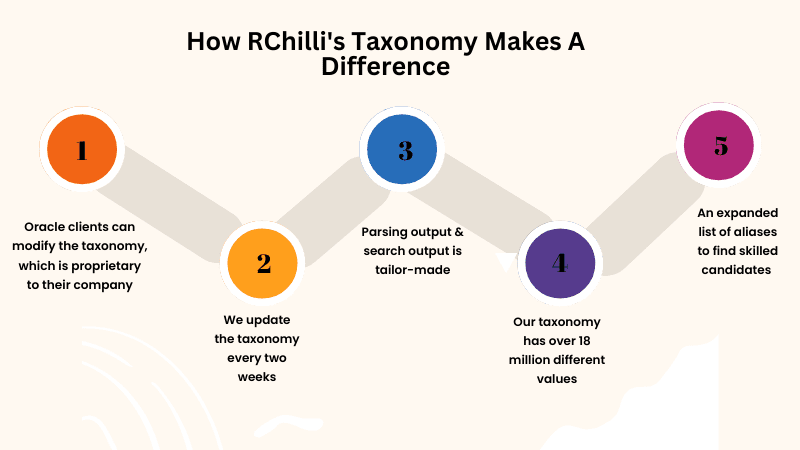
Benefits Of RChilli’s Skills Taxonomy for Oracle Users In Detail:
-
Facilitates An Accurate Assessment of the Candidate:
The expansive taxonomy enables the recruiters to set up an equitable assessment of the candidate. This helps them learn whether the candidate matches their skills, avoids ambiguity, and revamps the conventional hiring process.
-
Effectively Map The Skills Gap Analysis:
The expansive taxonomy guides a recruiter’s efforts to carry out a skills gap analysis. The team offers an extensive vocabulary of skills that help them to fill the gap within their existing skills glossary.
-
Enhance the Reach to Talented Candidates:
A resume is written by a human to be read by another human. They don’t write it with the idea of it getting parsed. It's natural that one may write a few skills differently or may even miss out on a few. With tons of aliases for each skill, RChilli makes hiring talented and qualified candidates easy. Taxonomy helps fill the skill aliases via automated assessment saving the recruiter a qualified candidate.
-
Generate Skills Profiles:
Employers can create skill profiles for open job positions using the taxonomy. This will help them realize their requirements better and subsequently seek the right match depending on their skills.
Is A Company’s Approach Towards Hiring Talented Candidates Changing?
The conventional hiring methodology includes a role-based approach, including- resume screening, hiring, and training the candidate to fulfill the defined responsibilities of the profile. This approach so far used to match the generic title and skills corresponding to the titles.
A skills-based hiring approach following skills taxonomy includes the set of key skills mentioned in the resume defining what an applicant can do and a cluster of matching skills names or aliases that fit the job profile.
Even though there’s no right or wrong approach, there’s an increase in companies adopting a skills-based hiring approach. This helps them look beyond the set or pre-defined parameters of a role's specific skills and capabilities.
Focusing on the set parameters may land the hiring managers a crisp set of candidates while excluding the talented ones simply because their resumes missed a few defined skills. A skills-based approach includes taxonomy as an invaluable asset that gives Oracle recruiters access to a detailed and expansive skills dictionary.
Using AI Recruitment Together With RChilli’s Skills Taxonomy
By applying skills and competencies taxonomy and understanding the skills gap within the company, filling the open job positions is not restricted to finding an ideal candidate who matches the job title and experience. It has lately been about adding new skills and finding the best candidates who help the company grow.
AI recruitment software, like RChilli’s taxonomy can help you with skills-based hiring. Want to know more about our skills taxonomy?


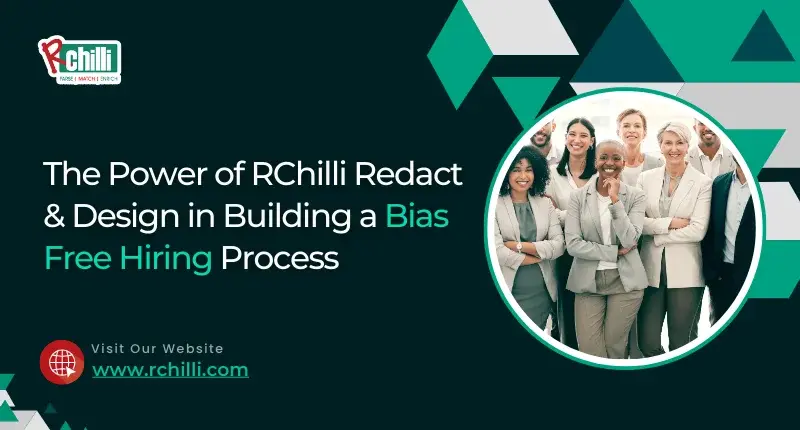
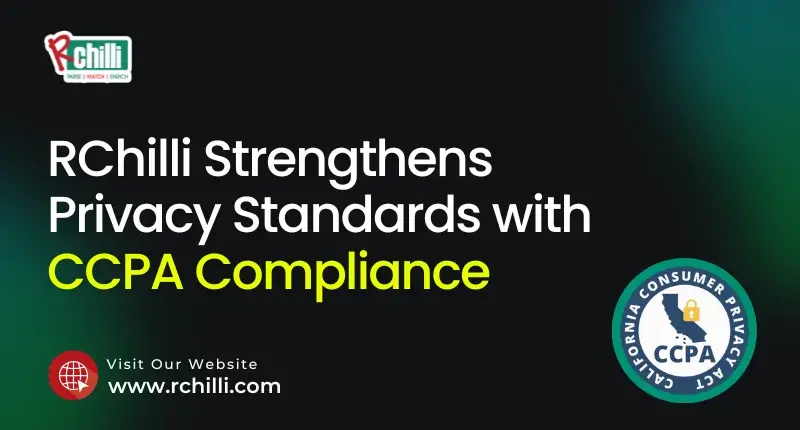
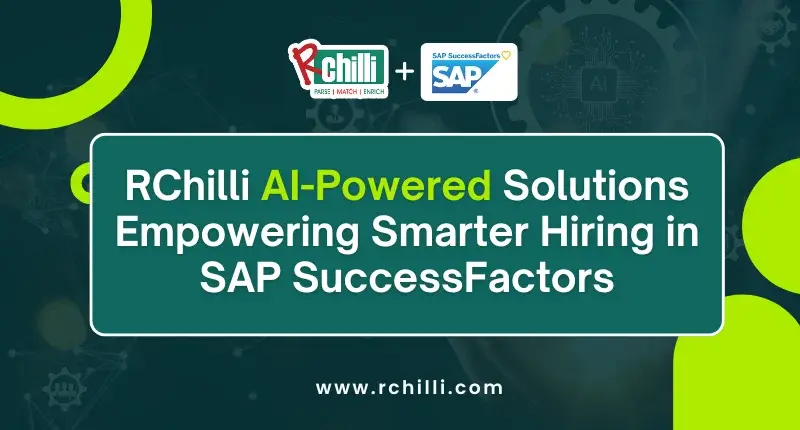
Leave a Reply